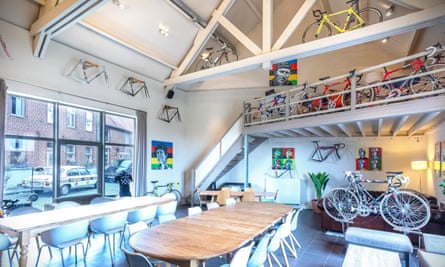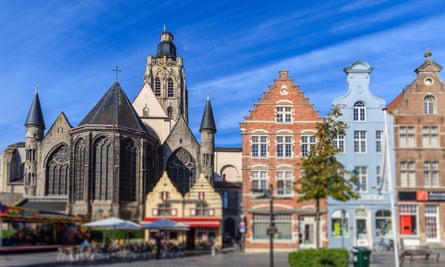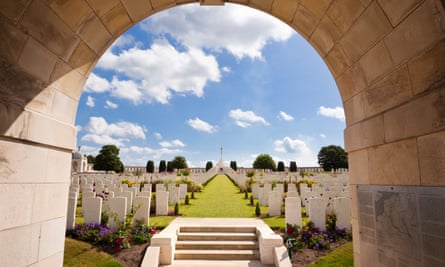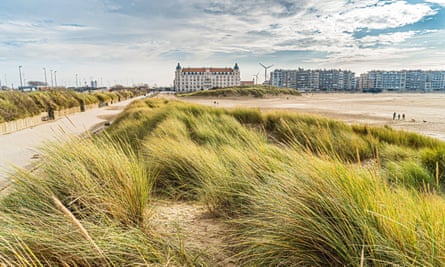
The Belgians love their cycling, but the Flemish worship it. The Flanders half of Belgium is laced with dedicated cycle routes carefully delineated and signposted. Whole towns close for road races. Bike sculptures lurk in fields. Posters of famous riders pepper high streets. Cycling runs deep in the culture here: that background hum you can hear? It’s the ceaseless whirr of oiled chain on metal cog.
As a result, cyclists from this part of the world, dubbed Flandriens, are deemed among the toughest on the planet thanks to their years of endurance in the wind and rain that tears across this open, flat country during the chill months, and for their ability to stay upright on the painful, treacherous cobbles.
Oh, those damned cobbles. Known locally as pavé, the geometric blocks are merciless and many have been in place for hundreds of years. They are the diametric opposite of the velvety smooth ride you get with tarmac. But it’s this unforgiving hardness that appeals to cyclists, and these sections are still associated with many of the classic spring cycle races, held in March and April, mainly on Belgian soil: nightmarish epics such as the Paris-Roubaix.
“Next time, bring a gumshield to protect your teeth from the juddering,” says a friend after punishing hours rattling over pavé, bikes and bodies threatening to come apart. No, next time I’ll miss out on the cobbles altogether – and thankfully that is an option. You can choose from long, short, lumpy and non-lumpy routes, or you can just please yourself in this most bike-friendly country with its amazing bike lanes – seemingly never-ending, a dream for Engish cyclists accustomed to abrupt kerbs, intrusive street furniture and foaming car drivers amped up on anti-LTN rage.
We’d rolled off LeShuttle at Calais the day before. Half an hour from Folkestone and then just over two hours to Brakel, a small town in the south of Flanders, handily placed for the Ronde van Vlaanderen loops, three circuits of the region: red, yellow and blue, between 80km and 115km, each carefully planned to ferret out the steepest of hills in this flattest of countries, and all punctuated with sections of teeth-shattering cobbles.
Our accommodation, the Flandrien Hotel in Brakel, is a cyclists’ haven: locked bike storage, space and tools for maintenance, laundry facilities and even a pressure washer. High-carb breakfast is included and keeps coming, while the communal breakfast/bar area is hung with scores of classic racing bikes for gear-heads to drool over.

But we came for the teeth-shattering experience of those infamous cobbles, and so we must commit. Day one is the 115km red route and the legendary Muur van Geraardsbergen, a staple of the Tour of Flanders. Its narrow, winding and rough- cobbled route hits a gradient of 20% in places, which sends back wheels spinning, desperate for grip on the greasy surface. At times you’re barely able to move fast enough to stay upright, and the final burst to the top of the viewing platform above the chapel leaves you teetering on the edge of a back flip.
Thankfully, from here the high point, the route rolls downhill into the countryside, past fields and through small villages on quiet roads. The first day ends with us slumped in deckchairs soaking up the late-afternoon sun back at the Flandrien Hotel: not all of us made the full 115km, but our second day will offer another chance when we hit the 102km yellow route.
The start and finish is in Oudenaarde at the De Ronde Centre. The centre has a café, cycle shop, occasional free servicing and shower facilities for cyclists. You can leave your bikes unlocked in the racks and still find them there when you return after visiting the centre’s exhibition on the history of cycling in the region. It’s here that you can also get your name on a plaque on the wall – all you have to do is complete the Flandrien Challenge on Strava: finish 59 mountain and cobble segments in less than 72 hours. I saw plenty of spaces left on the wall…

The yellow route is all about the cobbles. Sections of up to 2.5km in length that just keep coming, shaking water bottles free and threatening to chip teeth. It feels as if you’re holding a jackhammer rather than handlebars. The smooth sections, when they come, are like slipping into bed on silk sheets in a boutique hotel after a long day.
This time, most of us finish the full route – and even our bikes survive. For me, though, that’s enough cobbles for a lifetime.
Scenic routes: three historic and picturesque cycling days out in Flanders
Peace route, 45km

The Ypres Salient was an area of significant fighting during the first world war and there is much to see here. For the tour, you start in Ypres and ride past battlefields and cemeteries, including Tyne Cot Cemetery in Passendale, the German Soldatenfriedhof in Langemark and Essex Farm Cemetery in Boezinge.
Ghent château route, 48km

Meandering along the Scheldt river in western Belgium, this route takes in many grand houses and châteaux, including the beautiful moated Laarne Castle, built in the Middle Ages. It also passes the castles of Destelbergen, Heusden, Beervelde and Lochristi as well as taking you through the park and nature reserves at Gentbrugse Meersen and Kalkense Meersen.
Flanders coastal route, 93km

Launched as part of a scheme to create eight new long-distance cycling routes, which together will combine to form the much larger Flanders Route, this 93km wildlife-friendly coastal route takes you past beaches, rolling dunes and woods, passing the port of Zeebrugge and finally finishing near the border with the Netherlands.
For information on these and other cycling routes, go to fietsroute.org and cyclinginflanders.cc



